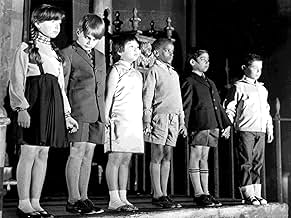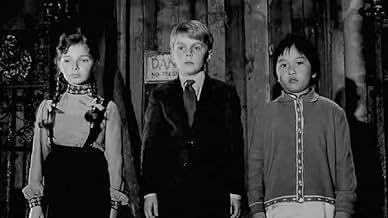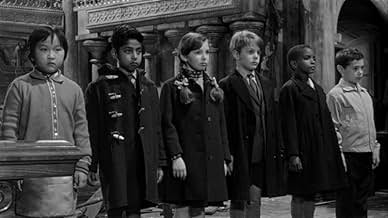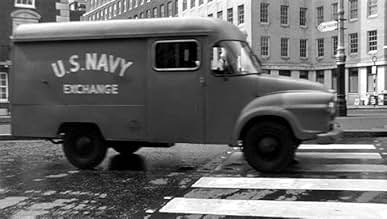Des scientifiques découvre six enfants de races différentes, dotés d'une intelligence supérieur et doués d'étranges pouvoirs. Sous observation à Londres , ils s'échappent du laboratoire et s... Tout lireDes scientifiques découvre six enfants de races différentes, dotés d'une intelligence supérieur et doués d'étranges pouvoirs. Sous observation à Londres , ils s'échappent du laboratoire et se réunissent dans une église..Des scientifiques découvre six enfants de races différentes, dotés d'une intelligence supérieur et doués d'étranges pouvoirs. Sous observation à Londres , ils s'échappent du laboratoire et se réunissent dans une église..
- Réalisation
- Scénario
- Casting principal
- Récompenses
- 1 nomination au total
- Russian official
- (as Andre Mikhelson)
- Mi Ling
- (as Lee Yoke-Moon)
Avis à la une
The film certainly has a respectable cast. Ian Hendry and Alan Badel play Tom Llewellyn and David Neville, who both give believable performances as the two scientists who uncover the children and their powers. Barbara Ferris plays the aunt of one of the children who ends up becoming a spokesperson for the children while under their control. Alfred Burke gives perhaps the film's best performance as British government agent Colin Webster whose involvement only makes the situation worse as the film goes on. Together they are a cast that is more then a match for that in the original film.
One of the film's problems though is in its title characters: the children. Due to whatever reason, gone are the seemingly normal yet otherworldly and menacing children of the original. These children are the exact opposite. They are utterly normal children from five places around the world who lack any of the otherworldly feeling or menace of the original children. Even the special effect used on the eyes when the children are using their powers isn't really used and, when it is, it just doesn't look stand up to the effect used in the original film. The result is that perhaps one, single essential element of the film that needed to work just doesn't work.
The production values of the film are excellent. In particular the stark black and white cinematography of Davis Boulton gives the film a strong sense of atmosphere and menace throughout which helps the film immensely. The production design of Elliot Scott give the film the same feeling as the cinematography, especially in the form of the destitute church the children come to occupy for much of the film. One element that improves in this film is the score by composer Ron Goodwin that, after a rather mixed result in the original film, is never out of place and put to good use throughout. The success of the production values helps the film out immensely.
Along with the children, the script is another essential element that ends up having a rather mixed result. If anything, the script presents this film as a rather confused sequel to say the least. The script seems to require that the viewer have seen the original film to understand all the events taking place. Yet the film seems to spend most of its time wanting to distance itself as far as possible from the original film. The result is a confusing mix: the plot and events make little sense without having seen the original film but the story might as well be anything but a sequel. It also doesn't help that the film, by the admission of screenwriter John Briley, was more or less meant to be more of a Cold War parable. The children can be viewed as scientists around the world who the major Cold War powers (represented by the government officials in the film) want to put to use building ever more powerful weapons of mass destruction. While this would be a good idea to have explored somewhere else, this film doesn't really seem to be either the place to do it or even do it well. If anything the script seems to be drowning in good ideas (such as the revelations that come out in the films last few minutes) that are never put to good use. Also the Cold War parable gives this film something the original doesn't have: a terribly dated feel to it. The result is that the script is a rather mixed affair.
Children Of The Damned, even when viewed on its own and not as a sequel, is a rather mixed affair. Despite a fine main cast and excellent production values, the film's supporting cast (the children) and its script both are rather mixed in their results. When viewed as a sequel however, the film comes across as a rather confused sequel that requires knowledge of the original film for it to make sense as well as being a terribly dated Cold War parable to the point of becoming a sequel in name only. All this means that, while a decent film, it never quite works either as a sequel or as an original film either and is a bit of a letdown overall.
Not as good as the original "Village..." but this sequel showed real promise. It's effectively filmed in moody black & white and has some very talented British actors giving good performances. Also the kids themselves are extremely spooky--especially when their eyes are glowing. It also shows how various countries want to use the children for their own gain. It also leads up to a (sadly) violent climax leaving most of the questions unanswered. Basically, it's a cop out and that's too bad. If you're going to set up a situation like this at least give it an ending...don't just end with violence (although that may be the point). Some people think this is better than the original but I disagree. Still, I was never bored and admired the direction and photography. Worth seeing, if you can handle the lousy ending.
These kids mean business!
Though this movie isn't quite as dark as its predecessor, VILLAGE OF THE DAMNED, it does offer political intrigue, a resurrection, and a cool secret weapon involving a pipe organ.
Highly recommended for fans of the original film...
Children of the Damned is generally considered to be a sequel to the excellent Village of the Damned; however, when viewed like this, glaring anomalies prevent it from being a fully satisfying experience. Children of the Damned is therefore best viewed as a standalone project; seen in this way, the film is more than worthy of any sci-fi/horror fan's time—an intelligent, thought-provoking piece that raises religious, ethical and philosophical debates and which, depending on how the somewhat ambiguous ending is interpreted, also delivers a prophetic warning: unless humans can overcome their innate distrust and fear of that which they do not understand, there can be no hope of survival for mankind.
Opinion about which of the 'of the Damned' films is better is seriously divided, but given the choice, I would always go for the freaky, blonde-haired and undeniably malevolent mutants of 'Village' over the normal looking, multi-cultural, and possibly benevolent saviours of mankind from 'Children'. Guess that's just how I roll...
Le saviez-vous
- AnecdotesPaul does not speak until almost an hour into the movie.
- GaffesThe geneticist character David Neville says that parthenogenesis (development of an egg without fertilization by sperm) is only in algae and plants, which would just be a character error if that is all that was known at the time, but even in the time period of the movie, parthenogenesis had already been documented in animals.
- Citations
Dr. Tom Llewellyn: At this very moment, they could be making all those men out there turn their guns on one another!
- Crédits fousIn the opening credits: "A sequel to John Wyndham's "The Midwich Cuckoos." This is the novel the previous film was based on and not the film's title.
- ConnexionsFeatured in Nightmare Festival (1989)
Meilleurs choix
Détails
- Date de sortie
- Pays d’origine
- Langues
- Aussi connu sous le nom de
- Children of the Damned
- Lieux de tournage
- Sociétés de production
- Voir plus de crédits d'entreprise sur IMDbPro
Box-office
- Montant brut aux États-Unis et au Canada
- 1 000 000 $US
- Durée
- 1h 29min(89 min)
- Couleur
- Rapport de forme
- 1.85 : 1




























